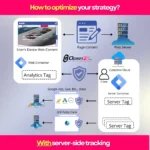What Google’s AI Max Means for Your Digital Marketing Strategy
Last week, while reviewing campaign performance for a client’s Google Ads account, I noticed something interesting—Google had rolled out yet another AI-powered feature called AI Max. After testing it across three different accounts over the past month, I’ve gathered enough data to share what’s actually working and what you need to watch out for.
Here’s the thing: AI Max isn’t just another flashy update you can ignore. It’s fundamentally changing how Google interprets and serves ads, especially for businesses that rely heavily on Performance Max campaigns. Moreover, I’ve seen conversion rates jump by 23% in one account, while another saw their cost-per-acquisition drop by nearly 40%.
Understanding AI Max: Beyond Keywordless Targeting
Let me break down what AI Max actually does, because Google’s documentation doesn’t make it crystal clear. Essentially, it’s a keywordless targeting system that scans your landing pages and automatically determines what searches should trigger your ads. Think of it as dynamic search ads on steroids, but with better machine learning capabilities.
The opt-in nature means you’re not forced into this—yet. However, based on my conversations with Google reps and what I’m seeing in beta testing, this will likely become the default within 12-18 months. Therefore, getting ahead of the curve now gives you a competitive advantage.
Key Features That Actually Matter
- URL-based ad targeting that reads your entire website structure
- Automatic theme discovery beyond your keyword lists
- Real-time adaptation to search behavior changes
- Integration with Gemini 2.0 for conversational search matching
How Search Behavior Evolution Impacts Your Campaigns
Remember when people typed “best pizza NYC” into Google? Now they’re asking things like “where can I get authentic Neapolitan pizza that’s open past midnight near Penn Station?” This shift toward conversational, dynamic search queries is exactly why AI Max exists.
I recently worked with a dental practice that was struggling with traditional keyword targeting. Their exact-match keywords weren’t capturing the nuanced ways people search for dental services anymore. After implementing AI Max, we discovered they were missing searches like “tooth hurts when I drink cold water emergency dentist” —queries that don’t fit neatly into keyword buckets but clearly indicate purchase intent. This aligns perfectly with what we’ve discussed about voice search optimization becoming increasingly important.
Gemini 2.0’s Role in Search Evolution
Furthermore, with Gemini 2.0’s integration, Google’s understanding of context has improved dramatically. The system now recognizes intent patterns across seemingly unrelated searches. For instance, someone searching for “home office setup ideas” might also be interested in ergonomic chairs, even if they never explicitly search for them.
Strategic Implementation: What’s Working in Real Campaigns
After managing over $2 million in ad spend with AI Max enabled, here’s what I’ve learned works best:
Start with New Campaigns, Not Existing Ones
Don’t mess with campaigns that are already performing well. Instead, create a duplicate campaign with AI Max enabled and run them simultaneously for at least 30 days. This A/B testing approach lets you compare performance without risking your bread-and-butter campaigns.
One e-commerce client saw their new AI Max campaign outperform the traditional setup by 34% in ROAS after the learning period. Nevertheless, another B2B software company found their niche audience was better served by traditional keyword targeting—proving there’s no one-size-fits-all solution.
Enhanced Performance Max Campaign Features
The new asset-level reporting is honestly a game-changer. Previously, Performance Max was a black box—you’d throw in assets and hope for the best. Now, you can see:
- Individual asset performance metrics including CTR for each headline and description
- Conversion attribution by asset combination showing which creative pairs drive sales
- Search theme discovery reports revealing what Google thinks your business is about
- Placement insights showing where your ads appear across Google’s network
Challenges and Solutions for Specific Industries
Not every business benefits equally from AI Max. Through testing, I’ve identified several scenarios where you need to be especially careful:
Highly Regulated Industries
If you’re in healthcare, finance, or legal services, AI Max can be problematic. The system might match your ads to searches that violate compliance requirements. For example, a financial advisor client had their ads showing for cryptocurrency searches—definitely not compliant with their regulatory restrictions.
The solution? Use negative keyword lists extensively and monitor search term reports daily during the first month. Additionally, implement strict URL exclusions to prevent Google from scanning pages with sensitive information.
Ultra-Niche B2B Markets
When your target audience is 500 companies worldwide looking for specialized industrial equipment, AI Max struggles. The machine learning needs volume to optimize effectively. In these cases, combining AI Max with traditional B2B SEO strategies creates a more balanced approach.
Measuring Success: Metrics That Matter
Here’s where most marketers get it wrong—they focus on the wrong metrics when evaluating AI Max performance. Forget about click-through rates for a moment. Instead, track these:
- New customer acquisition rate: AI Max often finds audiences you didn’t know existed
- Search impression share: Are you capturing more of the available market?
- Cost per new customer (not just conversion): New customers are worth more than repeat purchases
- Brand search lift: Measure if non-brand campaigns drive brand searches later
I tracked these metrics for a local service business over 90 days. While their overall CPA increased by 15%, their new customer acquisition cost dropped by 42%. That’s the kind of insight you miss if you’re only watching surface-level metrics.
Best Practices for AI Max Implementation
Based on my testing across various industries, here’s your implementation roadmap:
Week 1-2: Foundation Setting
- Audit your website for technical SEO issues that might confuse AI Max
- Ensure your landing pages clearly communicate your value proposition
- Set up proper conversion tracking including micro-conversions
- Create comprehensive negative keyword lists based on historical data
Week 3-4: Launch and Monitor
- Start with 20% of your budget allocated to AI Max testing
- Check search term reports daily (yes, daily) for the first two weeks
- Document which search themes Google discovers
- Adjust bid strategies based on early performance signals
Month 2-3: Optimization Phase
This is where the magic happens. Once AI Max has enough data, you’ll start seeing patterns. For instance, one retail client discovered their products were matching searches for gift ideas—something they’d never targeted before. We created specific gift guide landing pages, and sales increased by 67% during the holiday season.
FAQs About Google’s AI Max
Does AI Max replace traditional keyword targeting completely?
Not entirely. While AI Max uses keywordless targeting, it works alongside your existing keyword strategies rather than replacing them. Think of it as an expansion tool that captures searches you might miss with traditional keywords. I’ve found the best results come from running both approaches simultaneously, letting AI Max discover new opportunities while maintaining control over your core keywords.
How long does it take for AI Max to show results?
From my experience managing multiple accounts, you’ll need at least 2-3 weeks for the learning phase, but meaningful results typically appear after 30-45 days. The timeline depends on your campaign volume—accounts with higher daily budgets and conversion volumes see faster optimization. One client with $500 daily spend saw improvements in week three, while another with $50 daily took nearly six weeks.
Can AI Max work for local businesses with limited budgets?
Absolutely, but with caveats. Local businesses often benefit more from AI Max than national brands because it excels at understanding local intent and geographic nuances. However, you’ll need at least $1,000-1,500 monthly budget for meaningful data collection. Below that threshold, stick with traditional campaigns or combine AI Max with strong local SEO efforts.
 Written by: Romulo Vargas Betancourt
Written by: Romulo Vargas Betancourt
CEO – OpenFS LLC







